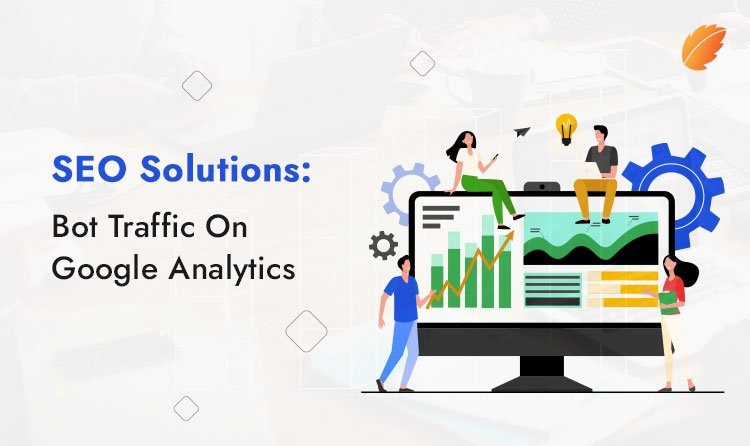SEO Solutions: Bot Traffic On Google Analytics
An overwhelming number of users under the ‘All Users’ on the Google Analytics account might come off as excitement for any SEO company. But is it worth celebrating? Of course, it is. Or maybe not.

You need ten minutes to determine if the increasing number showing on the screen will call for a celebration or make your SEO agency rework a solution for the problem.
One of the main reasons your Google Analytics data is inaccurate is because of the presence of spam or bot traffic. This traffic might not be genuine and are just a bunch of spiders and bots crawling on your website. This traffic is unwanted and gets attracted to your website without any investment in professional SEO services or SEO efforts.
The spam detection checklist it’s a bit hard to follow but not impossible. Let’s look at some ways to identify spam traffic on your website.
How to identify Bot or Spam Traffic on Google Analytics?
The first and foremost step any company providing digital marketing services or having a well do knowledge of SEO can take is to filter out the spam in the beginning.
But, we all know this is not enough to avoid unwanted traffic. Your online marketing services team will keep getting newer spam sources from time to time. The best thing you can do is have a Google Analytics audit twice or thrice a year.
The following four metrics can lead you towards your website bot traffic:
- Average Session Duration
- Bounce Rate
- Pages/Session
- New Users
One can easily find these GA metrics under the Overview section of the Audience sub-menu. Mostly it’s as simple as identifying which metrics are throwing suspiciously high or low numbers.
1. Average Session Duration
Average Session Duration in GA refers to the average duration a user has spent on a website. It only counts one session per user.
Usually, bot traffic doesn’t stick to a particular website for long. It doesn’t research or read blogs but simply lands on specific web pages. It also lands and bounces back frequently.
2. Bounce Rate
A bounce rate user will only land on a particular page and leave without engaging with the content, next page, or taking any kind of action on the website. It’s a powerful metric to indicate any issue with the website.
Therefore, if a user lands on a page and leaves without clicking another page, it will be a Bounce. Presently, the Bounce rate has a new name in GA4- Engagement Rate.
An abnormally high Bounce rate never always indicates some inherent issues with the Bot traffic. But, a consistently low Bounce rate may be a definite sign that there is something wrong with the website.
3. Pages per Session
You can see users going through multiple pages per session if the quality of traffic is not spam. Any SEO agency can tell you that organic traffic will click around, engage with the website and move through the pages.
If Pages per session decrease and traffic increases, it’s the strongest indicator of bot traffic.
4. New Users
When GA reports 100% new users to the website with an increase in the number of users, the traffic might not be real. You can also set up a comparison with the past figures to know better.
With the right digital marketing solutions, you can quickly solve this issue. Let’s discover how it is possible.
How to remove Bot traffic from your website?
If, at last, after going through the relevant metrics and checking the location and authority of referral traffic on Google Analytics, you’ve found that there, in fact, is Bot traffic on your website. To become the best SEO company, you can do one of the following to take care of the issue at hand.
Option 1: Disavow Spammy Backlinks
As part of your digital marketing services, you can ask your provider to disavow the spammy links. But, before taking any actions, make sure that the link is really harmful to your website.
Google will provide a Disavow suggestion in two conditions:
Either the link is a spammy or low quality, which is directing to your website, and
The links may cause a manual action to your website or have already caused one.
Option 2: Filter Bot traffic in Google Analytics
Google is quite resourceful and self-sufficient in filtering out Bot or spammy links from your website. With this option, you are on the safer side as you don’t have to go through the trouble to Disavow any link which might not be spam after all.
Even without an SEO provider service, you can do the following to filter out spam traffic.
- Go to the Admin section in the bottom left corner
- Choose View from the settings
- Find the option that reads ‘ Exclude all hits from known bots and spiders
- Click the checkbox opposite the option
- Choose Save.
Closing Words-
If you’re into professional SEO services, you might already be aware of the fact that most websites have spammy links. There will always be a small percentage of Bot traffic, but it depends on you as you try to tackle that traffic and save your website from the potential harm that Bot traffic can do.
It’s always better to conduct a thorough review of your website analytics as and when you have the time. It helps identify anything fishy before it can impact your Domain and Page Authority.
You can read our blog on how to improve a Domain Authority and take some meaningful steps.
Consagous Technologies is the best digital marketing company in the USA, focusing on conversion-driven digital marketing services and end-to-end digital marketing campaign management.
To avail of quality SEO services USA, reach us and ensure better leads for your business.
Original Source:
https://www.consagous.co/blog/seo-solutions-bot-traffic-on-google-analytics